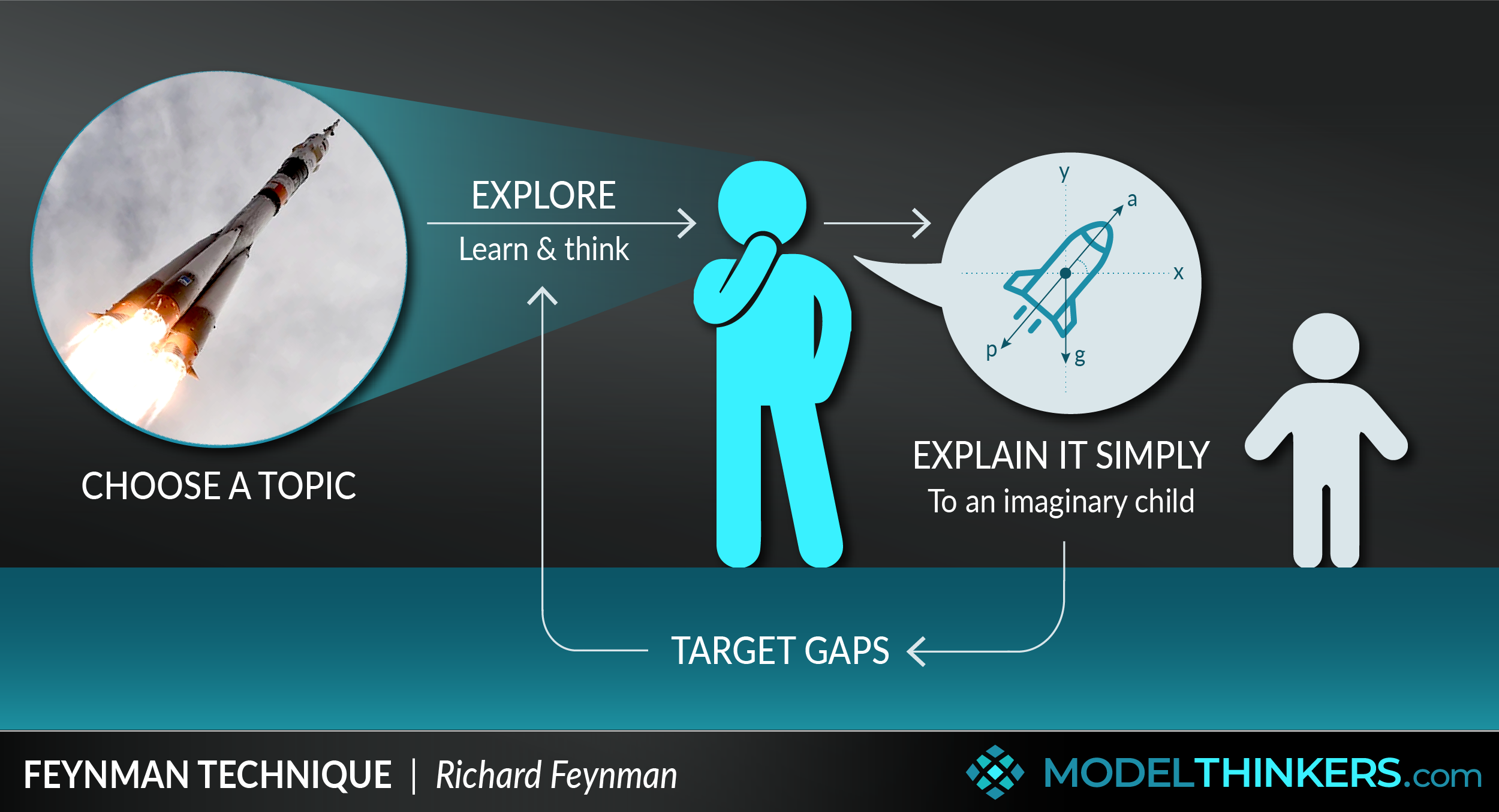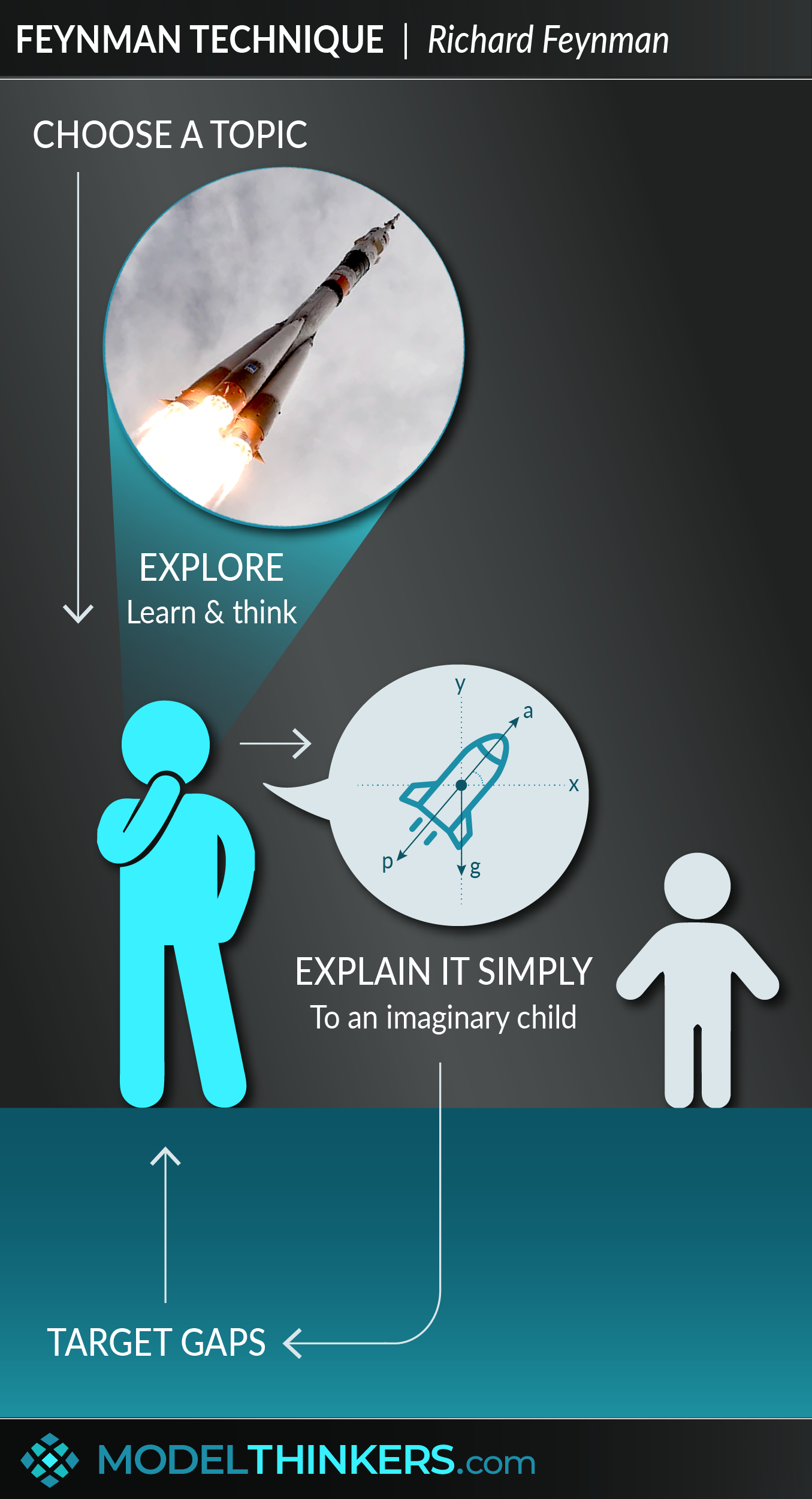

 0 saved
0 saved
 45.3K views
45.3K views








Einstein is credited with a wonderful quote that cuts to the heart of this model: “If you can’t explain it simply, then you don’t understand it well enough.”
The Feynman Technique is a learning and sense-making method that involves explaining a new concept to an imaginary child to expose gaps in your understanding and embed your learning.
KEY STEPS.
The Feynman Technique involves the following steps:
-
Choose a Topic. An area of study or complex concept.
-
Explore. Research, think about and learn about the topic.
-
Explain it simply. Imagine explaining it to an intelligent child. This includes using simple language, analogies and/ or diagrams.
-
Target your gaps. Continue to explore the topic, targeting the areas you struggled to explain and simplify.
IT’S MORE POWERFUL THAN YOU MIGHT THINK.
The Feynman Technique is a deceptively simple approach that delivers a range of benefits, including increasing your ability to:
-
Learn rapidly: it pinpoints your knowledge gaps making your study time targeted and efficient.
-
Learn despite biases: It challenges your ‘illusion of competence’, where recognising content is mistaken for understanding and learning it.
-
Integrate with Spaced Retrieval: it can feed into the ‘retrieval’ aspect of Spaced Retrieval, which is one of the most evidence-based memory hacks available.
-
Leverage a ‘teachers mindset’: it puts a learner in the mindset of having to explain what they’re exploring, which has been shown to increase learning.
-
Make connections: the use of analogies and diagrams helps to connect new concepts with your prior knowledge and mental models, which is at the heart of effective learning and understanding.
MORE THAN A STUDY HACK, A WAY OF THINKING.
The Feynman Technique is generally posed as a ‘study hack’, but we’d argue it has broader application to experiential learning and sense-making. Framing any experience with the need to explain your lessons will help you to embed deeper reflection, sense-making, and learning as habits.
LEARN OUT LOUD.
You can go further with The Feynman Technique by moving beyond pretend conversations with an imaginary child and consider how you might communicate your learning via real conversations, blog/ social media posts, journals, videos, or other forms of presentations.
You can share the fact that you're still new to the topic as a form of 'learning out loud.' Doing this has the joint benefits of learning and helping to build your personal learning network and community.
DEVELOP A CULTURE OF LEARNING.
We've focused on the personal pay-offs of this model, but also consider applying the Feynman Technique at scale. It's an intuitive approach that can be used to promote a broader culture of knowledge sharing and continuous learning in teams and organisations. It focuses on the win-win for a 'teacher', who is being required to simplify and explain concepts, and a 'student', who receives the benefits of clearer, concise explanations.
IN YOUR LATTICEWORK.
We’ve already highlighted how the Feynman Technique is a powerful companion to Spaced Retrieval. It also supports reflection techniques such as Double-Loop Learning and, at scale, will be dependent on the level of Psychological Safety in a team and organisation.
The need to simplify and get to the core of a concept can be seen as a practical application of Occam's Razor and First Principle Thinking. Finally, consider the connection between this model and the Advice Giving Effect in exploring the win-win of teaching and learning.




- Imagine explaining a new concept to an intelligent child.
Whatever you’re trying to learn, practice explaining it to an intelligent child using simplified language to expose the gaps in your knowledge and help to embed your learning.
- Use analogies and diagrams.
Where possible explain the concept with analogies and/or diagrams that force you to simplify and make connections with your prior knowledge.
- Embrace the Feynman Technique as a mindset.
Rather than something you apply as a study hack, consider using the Feynman Technique as a way you approach every new experiment, experience or venture to embed reflection, sense-making habits and learning habits.
- Learn out loud.
Consider moving beyond imaginary conversations to actually share your learning with your network, peers, team and others. This might be team presentations, social media posts, starting a blog, or a simple conversation.
The main issue with the Feynman Technique is that while your inability to explain something simply will tend to reveal your lack of understanding; it is also likely that there will be situations where you can explain something simply and you do not understand the complexity behind it.
That is, your ability to over-simplify will not always reflect a deeper understanding.
Interestingly, despite being called 'The Great Explainer' Feynman was also quoted as saying in relation to his work: "Hell, if I could explain it to the average person, it wouldn't have been worth the Nobel Prize."
Feynman diagrams.
Feynman commonly used diagrams in his work with his most famous example simply known as the ‘Feynman Diagram’ developed in 1948 as a conceptual representation of the interaction of subatomic particles.
This interaction is extremely complicated, yet Feynman’s visualisation helped him develop clarity on the topic and countless others to understand it.
This version is from Wikipedia - where e- = electron; e+ = positron annihilate, producing y, a photon. The photon becomes a quark-antiquark pair, and the antiquark radiates a g, glucon. Simple right ;).
Wired 5 levels series.
This brilliant series by Wired Magazine, takes experts in a range of fields and has them explain a complex concept at 5 levels of difficulty. Well worth checking out.
d
The Feynman Technique is named after famous physicist Richard Feynman who lived from 1918 to 1988 as was known as the 'Great Explainer'. A Nobel-prizewinning theoretical physicist, Feynman worked in the areas of quantum and particle physics and developed key ideas behind quantum computing and nanotechnology.
He was also a key member of the team that created nuclear bombs as part of the Manhattan Project, and would be considered to have had a 'challenging' relationship with women to say the least.
While he didn’t explicitly outline the technique, he was known for his deliberate learning strategies from his time at Princeton and throughout his career. Feynman was a champion of cross-disciplinary curiosity and, as the 'Great Explainer', he not only embodied the technique named after him, he used it to leave a legacy of strong scientific thinking and inquiry.
In Genius: The Life and Science of Richard Feynman, biographer James Gleick’s described how Feynman kept a journal entitled ‘Notebook of things I don’t know about.’ Rather than just reviewing content, he would actively capture it, reconnect it, and express it.
At the same time, he was also known for his ability and practice to capture complex ideas simply. See the In Practice tab for the example of the Feynman Diagram.
 My Notes
My Notes
Oops, That’s Members’ Only!
Fortunately, it only costs US$5/month to Join ModelThinkers and access everything so that you can rapidly discover, learn, and apply the world’s most powerful ideas.
ModelThinkers membership at a glance:






“Yeah, we hate pop ups too. But we wanted to let you know that, with ModelThinkers, we’re making it easier for you to adapt, innovate and create value. We hope you’ll join us and the growing community of ModelThinkers today.”








































































































































